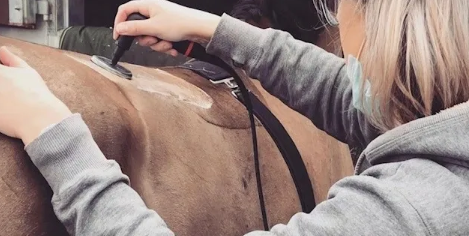
Posted on 20th October 2022
by Jess Howard

INDIBA is a monopolar radiofrequency device, operating at 448KHz, which has been found to be the most optimum frequency based on over 300 scientific references.
The technology has been around for more that 3 decades in the human medical field, and 80% of premiership football clubs use it, but is still considered an emerging technology in animal health, despite the wealth and volume of excellent research and clinical outcomes.
From the INDIBA website:
Because it works in a closed circuit, it can treat deep tissues, which other electrotherapies / electrophysical agents such as LASER, pulsed magnetic field therapy, shockwave etc. cannot reach.
So as well as being excellent for the treatment of superficial tissue, wounds, oedema, bruising, muscle, tendon and ligament damage (the research speaks for itself!) It can also be used for conditions such as kissing spines and other back dysfunction, sacroiliac dysfunction / disease, and fractures. It can even be used over areas with metal implants. It can be used very effectively for the management of arthritis, particularly in the hocks, and for general performance enhancement.
Tendon injuries make up a large proprtion of the issues faced by sport horses, with around 50% of racehorses experiencing them (Arguelles et al., 2018). A study by Çalişkan et al., (2020) described 85% of tendonitis cases staying away from racing for an average of nearly 40 months. Although up to 60% do return to work, a staggering 80% also relapse (Dowling et al., 2005, Dowling et al., 2010). This obviously has financial implications and so treatment modalities that can speed up return to work, and improve outcomes are a sensible investment. In a case study by Argüelles et al., (2018) all the horses that were treated with INDIBA® returned to their previous competition level after 5-6 months of treatment. Muñoz et al., (2018) demonstrated INDIBA® “produces a clear effect in the regeneration of the damaged tissue, shortening its healing time“.
In another case study conducted by Campos et al., (2018) the INDIBA®, when used on an SDFT injury, produced an anti-inflammatory visible to the naked eye from the first treatment. Regeneration of the broken tendon fibres, and a more organised and consistent fibre pattern was verified 6 weeks later upon the post-treatment ultrasound. Lack of fibre alignment and elasticity, and thickening of the tissue are some of the main causes of recurrence in superficial digital flexor tendon injuries (Agüelles et al., 2018). When applied during the healing stages of an injury, the INDIBA® improves outcomes of all three of these factors (Agüelles et al., 2018).
There is promising research evidence surrounding the use of treatments such as platelet rich plasma (PRP) and stem cell therapy for treatment of tendon and ligament injuries. As INDIBA® has a biostimulatory effect and increases cellular metabolism, it can optimise results from these treatments. Unlike treatment modalities such as shockwave therapy, the sensation is a pleasant one, and horses do not require sedation. In fact, most demonstrate a more relaxed state during treatment.
In a case study involving a chronic suspensory ligament injury, Campos et al., (2018) demonstrated an improvement in the quality of fibres in the ligament, and the disappearance of anechogenic and hypoechogenic areas, as well as a decrease in oedema and inflammation after the third session. However, the horse treated showed clinical deterioration 8 weeks after the last treatment, suggesting that maintenance treatments would be required in chronic cases.
In a case study involving a fracture of the third metatarsal, inflammation was noticeably reduced after the first INDIBA® treatment, and even more so after the third. At 4 months post injury, the radiographs demonstrated even ossification, and the horse was sound. The study concluded use of RF reduced healing time and improved bone consolidation results (Campos et al., 2018).
RF treatment can also accelerate healing in soft tissue wounds and injuries (Campos et al., 2018), improve stride length and regularity (Becero et al., 2020), increase back flexibility and decrease thoracolumbar and epaxial pain (Argüelles et al., 2020).

Sarah is qualified in veterinary physiotherapy to post-graduate level (Master of Science). She is an executive committee member of the National Association of Veterinary Physiotherapists, and is registered with the Animal Health Professions’ Register (AHPR) as under the veterinary physiotherapy sub-group, as well as siting on their board. She holds a BSc (Hons) in Animal Behaviour and Welfare and has a keen interest in performance enhancement. She has previously worked for a national animal welfare charity, and is a qualified lecturer. She now guest lectures and provides CPD for a range of organisations, as well as teaching and assessing vet physio students at post-grad level. Sarah covers East and North Yorkshire, and parts of South Yorkshire and Lincolnshire, with further travel available upon request.
White Rose Therapy & Training – Equine Advertiser Directory
White Rose Veterinary Physiotherapy – website
Subscribe today for all the latest Equine Advertiser news and offers direct to your inbox